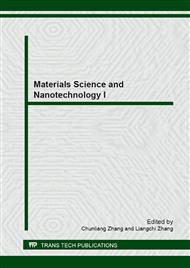p.500
p.504
p.508
p.512
p.519
p.523
p.527
p.531
p.535
The Effect of Density and Surface Area on Carbon Nanotube Capacitive Sensors for Dimethyl Methylphosphonate Detection
Abstract:
Capacitive sensors for dimethyl methylphosphonate (DMMP) detection were prepared on interdigitated electrodes by airbrush process. Multi-walled carbon nanotubes (MWNTs) and single-walled carbon nanotubes (SWNTs) were used as the chemically sensitive materials, respectively. Different airbrush carbon nanotube thin films were observed and compared by field-emission scanning electron microscope. It indicated that the capacitance of airbrush MWNT sensor decreased immediately when exposed to DMMP and recovered rapidly when removed DMMP in the range of 12-60 mg/m3 (2.4-12 ppm). The sensitivity of airbrush MWNT sensor was about -1.39% at the concentration of 12 mg/m3 (2.4 ppm). It was obvious that the capacitance sensitivity was higher when the MWNTs were more and the film was denser by airbrush. It was also found that the capacitance sensitivity of airbrush SWNT sensor was higher than the corresponding airbrush MWNT sensor.
Info:
Periodical:
Pages:
519-522
Citation:
Online since:
December 2012
Authors:
Price:
Сopyright:
© 2013 Trans Tech Publications Ltd. All Rights Reserved
Share:
Citation:


